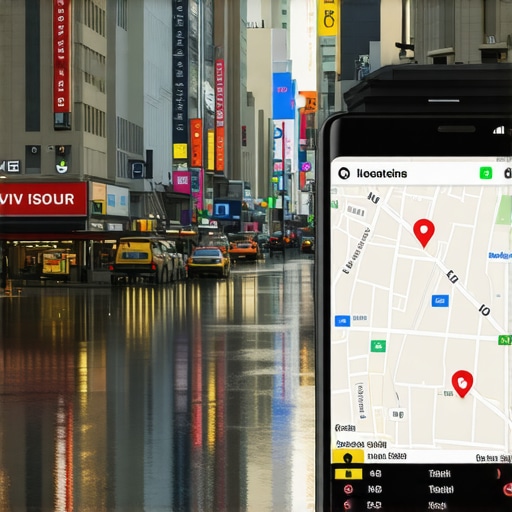Unlocking the Nuances of Maps SEO: A Strategic Perspective for 2024
In the rapidly evolving landscape of local search, mastering Google Maps SEO is no longer optional but imperative for businesses aiming at digital dominance. As search algorithms become increasingly sophisticated, understanding the layered intricacies of Google’s local ranking factors is essential. This article explores advanced techniques that leverage semantic SEO, user experience optimization, and authoritative reputation building to elevate your Google Maps visibility beyond conventional tactics.
Deciphering the Algorithmic DNA of Google Maps Rankings
Google’s local search algorithm integrates a complex array of signals, including relevance, distance, and prominence. Recent studies, such as those published in the Search Engine Journal, highlight the importance of structured data, review signals, and Google My Business (GMB) optimization. This layered approach demands a strategy that aligns technical SEO with user intent, ensuring your maps listing is both authoritative and contextually relevant.
Leveraging Semantic SEO for Local Map Optimization
Semantic SEO involves integrating Latent Semantic Indexing (LSI) keywords within your Google Maps content to capture a broader spectrum of search queries. For example, instead of merely optimizing for “pizza near me,” incorporate related terms like “best Italian restaurant,” “family-friendly pizzeria,” and specific dish keywords. When these semantic signals are embedded naturally into your GMB profile, reviews, and website content, Google perceives your listing as highly relevant, significantly boosting its ranking potential.
What Are the Hidden Factors Influencing Map Visibility in 2024?
How do local E-A-T principles impact Google Maps rankings, especially in competitive niches?
Expertise, Authoritativeness, and Trustworthiness (E-A-T) are critical in local SEO. Google prioritizes businesses that demonstrate credible expertise through detailed profiles, consistent NAP (Name, Address, Phone) information, and high-quality user reviews. Recent updates emphasize the role of authoritative backlinks and local citations, which serve as trust signals reinforcing your business’s reputation. Integrating these elements into your Maps SEO strategy enhances visibility and resilience against algorithmic fluctuations.
According to Moz’s local SEO guide, fostering genuine customer trust and authoritative citations are pivotal for sustained rankings in competitive sectors.
Enhancing Google Maps Visibility through User Engagement and Technical Precision
Beyond content, technical SEO plays a pivotal role. Ensuring your website is mobile-friendly, fast, and structured with schema markup aligned with your GMB data enhances your overall local SEO health. Additionally, actively managing reviews—responding professionally and encouraging satisfied clients to share feedback—builds social proof and signals to Google that your business is active and reputable.
Furthermore, leveraging local backlinks from high-authority domains and engaging in community-driven content can propel your Maps ranking. These efforts should be complemented with regular profile updates, including accurate categories, attributes, and optimized images.
Can Advanced Schema Markup Significantly Elevate Your Maps Visibility?
Implementing local business schema markup with rich snippets can provide Google with explicit context about your offerings, location, and operational details. This explicit data enhances search result listings with rich cards, increasing click-through rates and boosting local prominence. For detailed implementation guidance, consult Google’s Structured Data documentation.
To stay ahead in 2024, integrating these advanced schema and semantic techniques is vital. Explore more expert strategies at our comprehensive Maps SEO guide.
Engage with professionals and contribute insights to refine local search strategies further, ensuring your business remains a top contender in Google Maps rankings.
Unlocking the Power of Local Schema Markup for Maps SEO
One of the most potent yet underutilized tools in a local SEO arsenal is advanced schema markup. Implementing rich snippets through local business schema enables Google to better understand your business details, operational hours, services, and even specific attributes like wheelchair accessibility or payment options. This explicit data not only enhances your appearance in search results with rich cards but also improves click-through rates significantly. For comprehensive guidance, consult Google’s Structured Data documentation. Moreover, integrating schema with your website’s local content and Google My Business profile ensures a unified, authoritative presence that Google favors.
Is Your Content Strategy Future-Proofed for Local Search Evolution?
While technical optimizations are crucial, the core of Maps SEO success lies in your content strategy. Are you leveraging user-generated content, such as reviews and Q&A, to create a dynamic, engaging profile? Advanced content strategies include producing locally relevant blog posts, event announcements, and partnerships that foster community engagement. These efforts boost your relevance and authority, making your listing more attractive to Google’s ranking algorithms. As Google increasingly emphasizes user intent and experience, ensuring your content aligns with current local search trends will keep your business ahead of the curve. For innovative content ideas, explore our SEO tips for Maps and local search.
How can integrating AI-driven local SEO tools optimize your Google Maps visibility in 2024?
Emerging AI-powered tools are revolutionizing local SEO, providing insights into local search trends, competitor analysis, and keyword opportunities with unprecedented precision. These tools can analyze your Google My Business reviews, identify sentiment patterns, and suggest targeted improvements to boost your reputation management. Additionally, AI-driven content generation and schema markup optimization can streamline your technical SEO efforts, ensuring your profile remains aligned with evolving algorithms. Adopting these innovative solutions can give you a competitive edge, making your Maps SEO strategy both scalable and adaptive. For more on leveraging AI in local SEO, see our detailed guide at Maps SEO strategies for 2024.
Share your experiences or ask questions in the comments — your insights can help refine local search strategies for everyone!
Harnessing Local Data Unification to Amplify Map Visibility in Competitive Markets
In the quest for top-tier Google Maps rankings, one of the most sophisticated tactics involves unifying your local data across multiple platforms and directories. This process, known as local data canonicalization, ensures that your NAP (Name, Address, Phone number) details are consistent everywhere. Consistency not only boosts your credibility in Google’s eyes but also consolidates your local authority signals, leading to improved rankings.
Implementing a comprehensive local data management system involves auditing existing citations, correcting discrepancies, and deploying a centralized data hub. This approach reduces fragmentation, which can diminish your local relevance. According to Moz’s Local Search Ranking Factors (2024), businesses with unified, accurate citations see a measurable uplift in local pack visibility and organic map rankings.
Strategic Use of Hyperlocal Content and Geo-Targeted Landing Pages for Map Optimization
Beyond technical accuracy, the deployment of hyperlocal content tailored to specific neighborhoods or districts can dramatically enhance relevance. Creating geo-targeted landing pages that reflect unique local features, landmarks, or community events signals Google’s algorithms that your business is a vital part of the local fabric.
These pages should incorporate rich media, such as local images and videos, along with schema markup to reinforce local intent. For instance, a restaurant could develop pages for each neighborhood it serves, embedding reviews, menus, and maps. This hyperlocal strategy aligns with Google’s emphasis on contextual relevance, boosting your chances of appearing in local packs for diverse search queries.
How Does Google’s Use of Machine Learning Impact Local Search Results in 2024?
What role does Google’s BERT and MUM models play in refining local search relevance?
Google’s advanced language models, BERT (Bidirectional Encoder Representations from Transformers) and MUM (Multitask Unified Model), significantly influence local search outcomes. These models enable Google to better understand complex search queries, context, and user intent, especially in nuanced or conversational searches. As a result, local businesses that optimize their content for natural language and semantic depth stand to gain more visibility.
For example, a query like “best pet-friendly cafes near me that deliver” is now interpreted with deeper contextual understanding, rewarding businesses that incorporate detailed, naturally phrased content about their pet policies, delivery options, and local relevance. Adapting your content to match this evolving AI understanding involves focusing on long-tail keywords, FAQs, and comprehensive service descriptions.
To stay competitive, integrate AI-powered local SEO tools such as BrightLocal or SEMrush’s Local SEO Toolkit. These tools analyze how Google’s models interpret your content and provide actionable insights to enhance your relevance and prominence.
Leveraging User Engagement Metrics as a Ranking Signal in 2024
Google increasingly considers user engagement metrics—such as click-through rates, bounce rates, and review sentiment—as indirect signals of a business’s relevance and quality. Enhancing these metrics requires not only attracting clicks through compelling snippets but also ensuring your landing pages and Google My Business profile deliver value and foster interaction.
Encourage satisfied customers to leave detailed reviews, respond promptly to feedback, and utilize Q&A sections to address common queries. Embedding interactive elements like booking widgets or menu previews can improve dwell time and engagement, which in turn positively influence your map rankings.
Moreover, integrating machine learning-based sentiment analysis on reviews can help identify and address reputation issues proactively, maintaining your business’s trustworthiness and authority.
Conclusion: Future-Proofing Your Google Maps Strategy with Continuous Innovation
As Google’s algorithms continue to evolve, the key to maintaining and improving your Maps visibility lies in adopting an integrated, data-driven approach rooted in technical excellence, local relevance, and user engagement. Regularly monitor your performance through analytics tools, stay informed about algorithm updates, and experiment with emerging technologies like AI-driven content optimization and voice search adaptation. For those committed to staying ahead, the journey involves continuous learning and strategic adaptation.
If you’re eager to deepen your understanding of these advanced tactics, explore our comprehensive guide on Maps SEO Strategies for 2024. Share your experiences or ask questions in the comments—your insights can help shape the future of local search excellence!
Harnessing the Power of Local Data Unification for Unmatched Map Visibility
Achieving dominance in Google Maps rankings necessitates a meticulous approach to local data management. Local data canonicalization aligns your NAP (Name, Address, Phone Number) information across all digital touchpoints, ensuring consistency and boosting your local authority signals. This process involves a comprehensive audit of citations, correcting discrepancies, and deploying a centralized data platform to synchronize information seamlessly. As highlighted in Moz’s 2024 Local Search Ranking Factors, businesses implementing these practices see tangible improvements in local pack prominence and organic map rankings.
Integrating Hyperlocal Content and Geo-Targeted Landing Pages for Precision Optimization
Beyond mere technical correctness, deploying hyperlocal content tailored to neighborhood-specific queries significantly enhances relevance. Creating geo-targeted landing pages that showcase local landmarks, community events, and customer testimonials signals Google’s algorithms about your deep integration into the local fabric. Incorporate rich media, schema markup, and localized keywords to fortify this strategy, increasing your chances of ranking in diverse local searches. This approach aligns with Google’s emphasis on contextual relevance, positioning your business as a community cornerstone.
How Does Google’s Use of MUM and BERT Models Influence Local Search Outcomes in 2024?
Google’s advanced AI language models, MUM and BERT, profoundly impact local search result relevance. These models enable Google to interpret complex, conversational queries, and nuanced user intent more effectively. For instance, detailed service descriptions and long-tail keywords that mirror natural language are now rewarded with higher visibility. Incorporating comprehensive FAQs, detailed service pages, and context-rich content ensures alignment with these models’ understanding, ultimately enhancing your local search prominence.
Utilize AI-driven local SEO tools like BrightLocal and SEMrush’s Local SEO Toolkit to analyze how these models interpret your content. Such insights facilitate targeted optimizations that adapt to ongoing AI evolutions, ensuring your business remains competitive in an AI-augmented search landscape.
Elevating Engagement through Interactive Content and Reputation Optimization
Engagement metrics such as click-through rates, review quality, and user interaction are increasingly instrumental in ranking calculations. Encourage real reviews, respond professionally to feedback, and leverage interactive elements like booking widgets or menu previews to foster user interaction. Embedding these elements enhances dwell time and signals user satisfaction to Google, reinforcing your local authority. Additionally, sentiment analysis on reviews helps proactively address reputation issues, safeguarding your trustworthiness and visibility.
Is Your Website Ready for Voice Search and Conversational Queries in Local SEO?
With voice search adoption accelerating, optimizing for conversational queries is paramount. Focus on long-tail keywords, natural language FAQs, and structured data that facilitate voice assistant recognition. Developing content that directly answers common customer questions in a conversational tone positions your business favorably in voice search results, which are increasingly influencing local pack rankings.
Implement schema markup to enhance voice search snippets and ensure your business details are accurately represented. Staying attuned to voice search trends and integrating them into your local SEO strategy guarantees your visibility in this burgeoning modality.
Future-Proofing Your Maps SEO: Embracing AI and Data-Driven Innovations
The future of Google Maps SEO hinges on continuous innovation. Embrace AI-powered tools for competitor analysis, sentiment tracking, and content generation to stay ahead of algorithm updates. Regularly update your local data, optimize for emerging voice and visual search functionalities, and leverage machine learning insights to refine your strategies dynamically. This proactive approach ensures sustained prominence in Google Maps rankings amid evolving search paradigms.
To deepen your expertise, explore our comprehensive guide on Advanced Maps SEO Strategies for 2024. Engage with industry peers and share your success stories to foster collective growth in local search mastery!
Expert Insights & Advanced Considerations
1. The Power of Semantic Depth in Local Content
Leveraging semantic SEO is crucial for advanced Google Maps rankings. Integrating LSI keywords naturally into your local content enhances relevance and aligns with Google’s AI understanding, ensuring your listing captures a broader array of search queries and user intents.
2. The Critical Role of Data Unification
Consistent NAP information across all digital platforms consolidates your local authority signals. Implementing centralized data management reduces fragmentation, boosts credibility in Google’s eyes, and improves your visibility in the local pack.
3. Embracing AI-Driven Optimization Tools
Adopting AI-powered tools for sentiment analysis, competitor insights, and schema optimization provides a competitive edge. These technologies allow for dynamic adjustments aligned with ongoing algorithm updates and evolving user behaviors.
4. Hyperlocal Content and Geo-Targeted Strategies
Developing geo-specific landing pages with rich media and schema markup signals Google about your deep local integration. This hyperlocal approach enhances relevance for neighborhood-specific searches and diversifies your appearance in local results.
5. Voice Search and Conversational Optimization
Optimizing for natural language queries and voice assistants ensures your business remains visible as voice search continues to grow. Incorporate FAQs, long-tail keywords, and structured data tailored for voice recognition.
Curated Expert Resources
- Google’s Structured Data Documentation: Essential for implementing rich snippets and schema markup that enhance search appearance and click-through rates.
- Moz’s Local SEO Guide: A comprehensive resource on citation management, local authority building, and ranking factors.
- BrightLocal’s Local SEO Tools: Cutting-edge AI-driven tools for review monitoring, sentiment analysis, and competitor benchmarking.
- SEMrush Local SEO Toolkit: Advanced analytics for understanding Google’s AI models and optimizing content accordingly.
- Rankin Search’s Maps SEO Strategies 2024: Expert-curated tactics specifically designed for upcoming trends and algorithm updates.
Final Expert Perspective
In the rapidly evolving landscape of maps SEO, the most impactful insights revolve around semantic depth, data integrity, and leveraging AI-driven tools to stay ahead of Google’s sophisticated algorithms. Mastering hyperlocal relevance and voice search optimization ensures your business remains in the spotlight in 2024 and beyond. Engage continuously with cutting-edge resources and contribute your insights to shape the future of local search excellence. Your strategic mastery in Google Maps SEO is not just about rankings but establishing an authoritative presence that resonates with both users and search engines alike.
,




Olivia Carter
This article hits the mark on how multi-faceted Google Maps SEO has become, especially with the incorporation of semantic SEO and schema markup. From my experience managing local listings, ensuring NAP consistency across directories really does boost authority signals, as Moz emphasizes. I’ve recently started integrating hyperlocal content on dedicated landing pages for each neighborhood, and I’ve noticed a marked improvement in local pack visibility. What strategies have others found most effective for balancing technical optimizations like schema with engaging local content? I’d love to hear insights from those who’ve experimented with voice search optimization, particularly around crafting FAQs that align with natural language queries. It seems that as Google’s models like BERT and MUM get better at understanding conversational intent, our content needs to evolve quickly, which is both exciting and challenging. Overall, this post underscores the importance of continuous adaptation in local SEO, especially as AI and machine learning become more integral to Google’s algorithms.
Ethan Walker
This comprehensive post highlights the increasing importance of semantic SEO and AI-driven strategies in Google Maps optimization. From my experience working with local businesses, I’ve found that consistent NAP information combined with hyperlocal content really establishes authority and improves ranking stability. Implementing rich snippets with schema markup seems essential in enhancing visibility, especially for competitive sectors. That said, I’ve also noticed that engaging actively with reviews and community-driven content significantly boosts credibility—sometimes even more than technical tweaks. Since Google’s AI models like BERT and MUM continue to evolve, do you think there’s a point where purely content-focused signals might outweigh technical factors? How are others balancing the need for technical precision with creating authentic, user-centric content in their local SEO strategies? I’m interested to hear any real-world examples of how integrating these elements has changed your local ranking results recently.
Liam Mitchell
This post provided a well-rounded overview of what it takes to succeed with Maps SEO in 2024. I’ve been experimenting with hyperlocal landing pages for specific neighborhoods, and the impact on local pack visibility has been noticeable, especially when combined with schema markup to signal relevance. One challenge I’ve faced is maintaining NAP consistency across multiple directories without causing conflicts or errors. Has anyone here found efficient tools or processes that streamline this? Also, I’m curious how others are integrating AI-driven tools to analyze review sentiment and adapt their reputation management strategies accordingly. From my experience, proactive engagement with reviews and community content can sometimes have a bigger impact than technical optimization alone. As Google’s models like BERT and MUM become more sophisticated, do you see a shift toward content quality and user engagement overtaking technical factors? I’d love to hear your thoughts or share some strategies that have worked in your local SEO efforts.